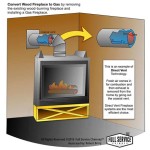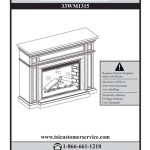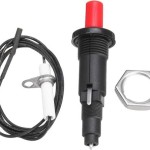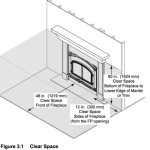How to Build an Outdoor Fireplace With Cinder Blocks
An outdoor fireplace provides a focal point for outdoor living spaces, offering warmth, ambiance, and a gathering place for friends and family. Constructing one using cinder blocks offers a cost-effective and relatively simple approach to adding this feature to a backyard or patio. Cinder blocks, also known as concrete masonry units (CMUs), are durable, readily available, and can be easily stacked to create a sturdy structure. This article outlines a comprehensive guide to building an outdoor fireplace using cinder blocks, covering planning, materials, construction steps, and essential safety considerations.
Planning and Preparation
Proper planning is crucial for a successful cinder block fireplace project. This phase involves determining the desired size and style, selecting a suitable location, and ensuring compliance with local building codes. Before commencing any construction, thoroughly researching local ordinances and obtaining necessary permits is essential. Regulations regarding fireplace construction vary widely, and failure to comply can result in fines or the need to dismantle the structure.
The design of the fireplace should complement the existing outdoor space and meet the intended use. Consider the size of the area where the fireplace will be situated, the desired height and width of the firebox, and any aesthetic preferences, such as incorporating a chimney or side storage for firewood. Simpler designs are generally easier to construct, especially for those new to masonry projects.
Selecting an appropriate location is equally important. The fireplace should be situated on a level surface, away from flammable materials such as trees, fences, and overhanging structures. Consider prevailing wind patterns when positioning the fireplace to minimize smoke blowing towards seating areas or the house. A minimum clearance of 10 feet from any structure is generally recommended.
Once the design and location are finalized, create a detailed plan or sketch that includes dimensions and material requirements. This will serve as a guide during the construction process and help ensure accurate material procurement.
Materials and Tools
Gathering the necessary materials and tools is the next step. The following list includes essential items for constructing a basic cinder block fireplace:
*Cinder Blocks:
The quantity will depend on the size and design of the fireplace. Estimate accurately based on the plan. *Mortar Mix:
Pre-mixed mortar is convenient, but mixing your own mortar is an option. Follow the manufacturer's instructions for proper mixing ratios. *Fire Bricks:
These are essential for lining the firebox to withstand high temperatures. *Grate:
A metal grate to support the firewood within the firebox. *Shovel:
For mixing mortar and moving materials. *Wheelbarrow or Mixing Tub:
For mixing mortar. *Mortar Trowel:
For applying mortar to the cinder blocks. *Level:
To ensure the fireplace is level and plumb during construction. *Rubber Mallet:
For gently tapping cinder blocks into place. *Safety Glasses:
To protect eyes from debris. *Work Gloves:
To protect hands from mortar and rough cinder block surfaces. *Measuring Tape:
For accurate measurements. *Chisel and Hammer (Optional):
For cutting cinder blocks if necessary. *Angle Grinder with Masonry Blade(Optional):
For cutting cinder blocks more efficiently. *Fire Clay Mortar:
Specifically designed for fire bricks, ensuring a heat-resistant bond.Before starting the project, ensure all materials are readily available and the tools are in good working condition. This will streamline the construction process and minimize delays.
Construction Steps
The construction of the cinder block fireplace involves several key steps. Firstly, a solid foundation is indispensable. Concrete is typically poured into a properly sized footing. The dimensions of the footing should exceed the dimensions of the fireplace base by several inches on each side. This provides a stable and level base for the structure. Allow the concrete to cure completely according to manufacturer’s instructions, usually several days to a week.
Once the foundation is ready, begin laying the first course of cinder blocks. Apply a generous layer of mortar to the foundation and carefully position each cinder block, ensuring it is level and aligned correctly. Use a rubber mallet to gently tap the blocks into place. Check for level and plumb regularly using a level and adjust as needed. The first course is critical, as it sets the foundation for the entire structure. Fill the cores of the first course with gravel for drainage.
Continue laying subsequent courses of cinder blocks, staggering the joints for added strength and stability. Apply mortar to both the top and sides of each block before positioning it. Remove any excess mortar with a trowel and smooth the joints for a neat appearance. Regularly check for level and plumb as the walls are built up.
When constructing the firebox, use fire bricks instead of cinder blocks. Fire bricks are designed to withstand the high temperatures of a fire and prevent the cinder blocks from cracking or crumbling. Apply fire clay mortar to the fire bricks and carefully position them within the firebox. Ensure proper alignment and tight joints. The firebox should be sized appropriately to accommodate a grate and allow for sufficient airflow.
If the design includes a chimney, continue building the cinder block structure upwards, gradually narrowing the opening to create a flue. A chimney liner is recommended to improve draft and protect the cinder blocks from smoke and creosote buildup. Consult local building codes for chimney height requirements.
After the mortar has cured, inspect the fireplace for any cracks or imperfections. Fill any gaps with mortar and smooth the surfaces. A decorative finish can be applied to the exterior of the fireplace, such as stucco, stone veneer, or paint, to enhance its appearance. Ensure any finish materials are heat-resistant and suitable for outdoor use.
Safety Considerations
Safety is paramount when building and using an outdoor fireplace. Adhering to safety guidelines is crucial to prevent accidents and ensure the long-term integrity of the structure.
Always wear safety glasses and work gloves during construction to protect eyes and hands. When mixing mortar, avoid inhaling dust and wear a dust mask if necessary. Use caution when cutting cinder blocks, as the process can generate sharp debris. Operate power tools safely and wear appropriate protective gear.
Ensure the fireplace is located a safe distance from flammable materials. Clear the area around the fireplace of dry leaves, grass, and other debris. Keep a fire extinguisher or garden hose nearby in case of emergency. Never leave a fire unattended, and supervise children and pets closely.
Burn only seasoned firewood in the fireplace. Avoid burning treated wood, plastics, or other materials that can release harmful fumes. Start small fires and gradually increase the size as needed. Do not overload the firebox with wood, as this can create excessive heat and potentially damage the structure.
Regularly inspect the fireplace for cracks, loose bricks, or other signs of damage. Repair any issues promptly to prevent further deterioration. Clean the chimney periodically to remove creosote buildup, which is a fire hazard. Consult a professional chimney sweep if necessary.
Be aware of wind conditions and avoid using the fireplace on windy days, as sparks and embers can be carried long distances. Consider using a spark arrester on the chimney to prevent embers from escaping.
Always dispose of ashes properly. Allow ashes to cool completely before removing them from the firebox. Place ashes in a metal container with a tight-fitting lid and store it away from flammable materials. Douse the ashes with water to ensure they are completely extinguished.
Alternative Design Options
While this article primarily focuses on a basic cinder block fireplace design, there are numerous variations and customizations that can be incorporated to suit individual preferences and needs. For instance, the fireplace can be designed with a built-in pizza oven. This would involve incorporating a separate chamber with a domed roof above the firebox, lined with fire bricks. A flue would need to be designed to vent the smoke and heat properly.
Another option is to add a grilling surface to the fireplace. This could be achieved by incorporating a metal grate or grill that can be adjusted to different heights above the fire. This would allow for cooking food directly over the flames.
For aesthetic enhancements, consider using decorative concrete blocks or adding a stone veneer to the exterior of the fireplace. This can create a more visually appealing and sophisticated look. Incorporating seating areas around the fireplace can also enhance its functionality and create a more inviting outdoor space.
Finally, consider adding a water feature, such as a small waterfall or pond, adjacent to the fireplace. The combination of fire and water can create a unique and relaxing ambiance.

How To Build An Outdoor Fireplace Contractor Broomfield Part 2

How To Build An Outdoor Fireplace Step By Guide Buildwithroman

Diy Outdoor Fireplace

Chris Loves Julia Diy Outdoor Fireplace Home Sweet Homes

Chris Loves Julia Diy Outdoor Fireplace Home Sweet Homes

Modern Diy Fire Pit Easy Build

Backyard Fireplace Part 2 Milk Paint

Diy Cinder Block Fire Pit Ideas Plans Pros And Cons

Masonry Your Diy Outdoor Fireplace Headquarters

Diy Fire Pit Made From Cinder Blocks Block Outdoor Designs Seating Area








